Geopolitical Grounds: Jong YuGyong, Koh Chaik Hong, Gabriel Leung, Chulayarnnon Siriphol, Nobuaki Takekawa
Ota Fine Arts Singapore is delighted to present "Geopolitical Grounds", a group exhibition featuring 5 artists from different parts of Asia: Jong YuGyong (Japan / South Korea), Koh Chaik Hong (Singapore), Gabriel Leung (Hong Kong), Chulayarnnon Siriphol (Thailand), Nobuaki Takekawa (Japan). This exhibition aims to showcase each artist's reaction to the current socio-political issues in their countries. From photography to video and painting, distinctive yet diverse expressions by the artists will bring new perspectives to our recognition of dynamics in Asia.
Koh Chaik Hong (b. 1994, Singapore) showcases works from his photo series, The Distanced Land (2015). He turns his camera lens to the suburbs of his home country, where urban development has been progressing steadily at the expense of nature. The very process of nature being invaded and destroyed is documented in this series of works, making viewers ponder on the value of urban development and its dilemma. Yet, Koh's works do not reveal dramatic or sensational scenes; rather, the images intrigue viewers through a silent voice heard from nature. Using photography, Gabriel Leung (b. 1983, Hong Kong) focuses on the contrast of nature and artificial objects in a different way. In his work Frontier Opened Area (2014), he photographs the border fence between Hong Kong and Shenzhen and prints the image on large fabric, which looks like a curtain you can walk through. The image shows a rather vernacular scenery with a tall metal structure surrounded by wild vegetation. However, once the history is unfolded, this scenery turns into a different view. This fence was built to prevent illegal migrants from mainland China to the former colonial city, symbolizing the political tension between the two political entities. At the same time, the political buffer has been a paradise for animals and plants, with limited access from human beings. The ambient sound recorded on the spot of photographing is also presented with the visual, as to create a holistic experience of this bizarre peripheric scenery.
Chulayarnnon Siriphol (b.1986, Thailand) presents his video work, Myth of Modernity (2014). The work talks about a crucial notion in Thai Buddhism - "three worlds". The pyramid-shaped ornate structures can be found at various places for worship in Thailand, as a symbol of "three worlds". The structure can be also seen in modern buildings in Bangkok nowadays still, but it seems to be losing its original meaning and only the form has been reproduced and applied to the architectural design. Similarly, observing protest by PDRC (People's Democratic Reform Committee) in 2013-2014, the artist notices a bizarre connection between the protesters' religious beliefs and political actions and draws a parallel discourse. Rather than documenting the protests directly, Siriphol creates his own narrative with affluent imagination towards cosmology and presents it in the 16 minute video work.
The painting series For One and Only Country (2017-) by Jong YuGyong (b.1991, Japan, currently based in South Korea) provides different perspectives to the relationship between visual experience and politics, and also one's globalized identity. Jong gets inspiration from North Korea's propaganda posters. He enlarges the original image and makes it into a collage-like painting. He even inserts some kind of "noise" to deform the image and also adds bright colours in the background. This repeated adjustment of distance and colours is deeply connected to his core idea. "This is my way to confront 'the feeling of alienation'", the artist puts, as a person who grew up in Japan with the identity of Korean origins. On the other hand, woodblock prints by Nobuaki Takekawa (b.1977, Japan) articulate the dilemma that the current Japanese society holds. Osprey and Okinawa (2016), at a glance, looks like a poster featuring animals. In the middle of the work is a flying bird, which is grabbing a fish with its claws. This bird's name is Osprey and it is also a nickname for the American tiltrotor military aircraft used in Japan. Japanese people held protests against the US military's plan to use this aircraft with the reason of high risks for accidents. Depicted on the body of the fish is the map of Okinawa, the southmost region of Japan where most of the US military bases in Japan are concentrated. This work provokes the question of the geopolitical situation of Okinawa.
Living in different environments, these artists are facing sociopolitical issues in their own local context, and their artistic approaches are equally diverse. However, at the same time, their works link each other and provide some threads to viewers to ponder on more universal issues in this post-modern world.
-
 Chulayarnnon SiripholMyth of Modernity, 2014Single-channel HD digital video16 minsedition 5 of 7 + 3 AP
Chulayarnnon SiripholMyth of Modernity, 2014Single-channel HD digital video16 minsedition 5 of 7 + 3 AP -
 Jong YuGyongFor One and Only Country 2 -Yellow-, 2018Acrylic on canvas
Jong YuGyongFor One and Only Country 2 -Yellow-, 2018Acrylic on canvas
156.2 x 110 cm
-
 Nobuaki TakekawaOsprey and Okinawa, 2016Woodblock print on paper130 x 97 cm (image size), 130 x 98 cm (paper size)Edition of 3
Nobuaki TakekawaOsprey and Okinawa, 2016Woodblock print on paper130 x 97 cm (image size), 130 x 98 cm (paper size)Edition of 3






